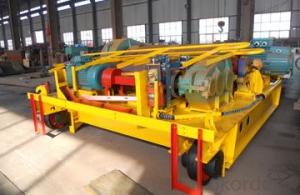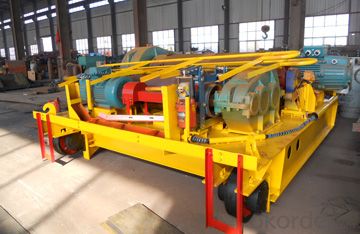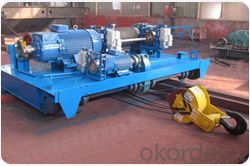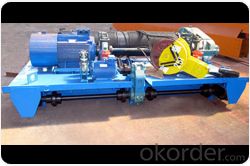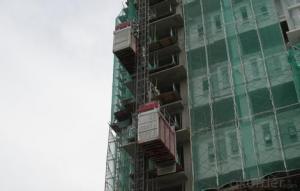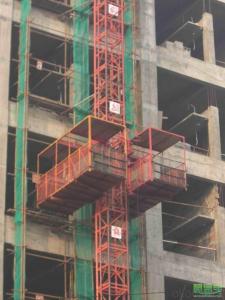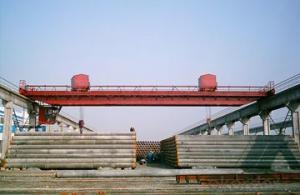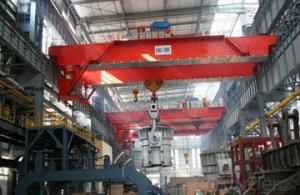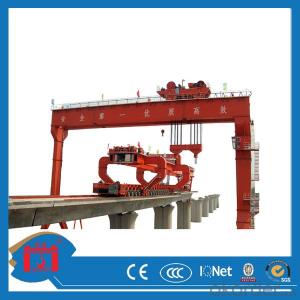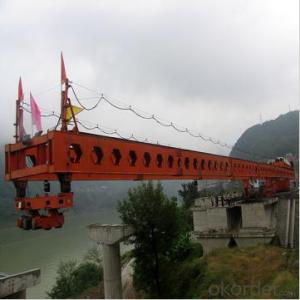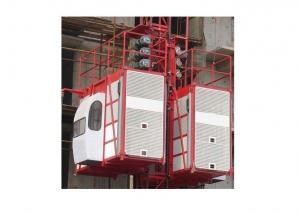Heavy duty electric trolley for double girder overhead crane and gantry crane
- Loading Port:
- Shanghai
- Payment Terms:
- TT OR LC
- Min Order Qty:
- 1 unit
- Supply Capability:
- 30 unit/month
OKorder Service Pledge
OKorder Financial Service
You Might Also Like
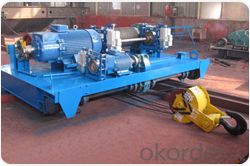
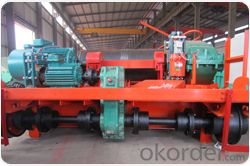
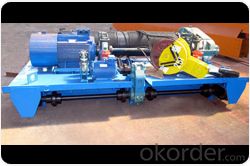
This trolley used in the double rail overhead crane, gantry crane. It is the overhead crane and gantry crane main lifting mechanism. It’s included motor , brake, reducer, drum and pulley. Motor through the gear reducer, drive the drum rotation, make wound reel or wire rope from the reel down, to lift heavy material. The trolley frame is bracket and install the lifting mechanism and trolley running parts, such as organization frame, usually for welding structure.It is equipped in the double girder overhead crane or double girder gantry crane as the lifting mechanism. It is suitable to work in all kinds factory, Mines, and the open air place, loading and unloading, and transporting materials in the fix span scope.
Features:
Reasonable structure and configuration
Favorable performance
Low noise
Convenient maintenance
High safety and precision
Starting and stoping smoothly
Technical Data:
Capacity | 5T/3.2T | 10T/3.2T | 16/3.2T | 20/5T | 32/5T | 50/10T | ||
Lifting height | Main | 16 m | 16 m | 16 m | 12 m | 16 m | 12 m | |
Aux. | 18 m | 18 m | 18 m | 14 m | 18 m | 16 m | ||
Lifting speed (m/min) | Main | A5 | 12.6 | 8.5 | 7.9 | 7.2 | 7.5 | 5.9 |
A6 | 15.6 | 13.3 | 13 | 12.5 | 9.5 | 7.8 | ||
Aux. | 16.7 | 16.7 | 16.7 | 19.5 | 19.5 | 13.2 | ||
Traveling speed | 37.2 | 43.8 | 44.6 | 44.6 | 42.4 | 38.5 | ||
Power supply | 380v 50hz 3-phase( Or as your requirement) | |||||||
- Q: What are the requirements for the construction elevator
- So for safety device factory test is very strict, before delivery by the statutory inspection unit for torque measurement, critical speed measurement, measuring the amount of spring compression, each with the test report, after assembly to the construction lifter for drop test under rated load, and the site to use the elevator must be every three months to conduct a drop test. For safety device to the factory for two years for safety device (delivery date), must also be sent to the statutory inspection unit to carry on the test, after testing once a year.
- Q: This question asks if a building hoist can be utilized in both commercial and residential settings.
- <p>Yes, a building hoist can be used for both commercial and residential purposes. These hoists are designed to lift materials and workers to various levels of a building under construction. In commercial settings, they are often used in high-rise buildings, while in residential construction, they are used for multi-story homes or apartment complexes. However, the specific type and capacity of the hoist should be chosen based on the project's requirements and safety regulations must be strictly adhered to in both types of construction.</p>
- Q: Does the misuse or incorrect use of lifting equipment pose a risk of injury to workers?
- <p>Yes, improper or incorrect use of lifting equipment can cause serious injury to workers. This can include accidents such as dropping loads, which can lead to crushing injuries or being struck by falling objects. Additionally, improper lifting techniques can lead to musculoskeletal injuries, such as back strains or sprains. It's crucial for workers to be trained in the safe operation of lifting equipment and to follow all safety protocols to minimize the risk of injury.</p>
- Q: Is it possible to utilize a building hoist for elevating materials to a significant height for stacking purposes?
- <p>Yes, a building hoist can be used for lifting materials that need to be stacked high. These hoists are specifically designed for construction sites to lift heavy materials vertically to different levels. They are equipped with safety features to ensure materials are lifted and stacked securely and efficiently. However, the height to which materials can be stacked will depend on the hoist's lifting capacity and the specific construction site's requirements. It's crucial to follow the manufacturer's guidelines and safety regulations when operating a building hoist to prevent accidents.</p>
- Q: Can a building hoist be utilized to lift more than one object simultaneously?
- <p>Yes, a building hoist can be used to lift multiple objects at once, provided that the combined weight of the objects does not exceed the hoist's maximum load capacity. This is often done by securing all objects to a single lifting point or using a pallet or platform to hold the objects together. It's crucial to ensure that the hoist is rated for the total weight and that the objects are evenly distributed to maintain balance during lifting. Always follow safety guidelines and manufacturer's instructions to prevent accidents.</p>
- Q: This question asks for criteria or factors to consider when selecting the appropriate type of building hoist for a specific construction project.
- <p>Choosing a suitable type of building hoist involves considering several factors: the weight and size of materials to be lifted, the frequency of hoisting, the height of the building, and safety requirements. Assess the load capacity needed, as hoists vary in their lifting capabilities. Consider the hoist's speed and efficiency to ensure it meets the project's timeline. The hoist's size and maneuverability are crucial for fitting within the construction space. Safety features and certifications should be verified to ensure compliance with industry standards. Consulting with hoist manufacturers or rental companies can provide insights into the most suitable hoist for your specific application.</p>
- Q: This question inquires about the cost of a hydraulic building hoist.
- <p>The cost of a hydraulic building hoist can vary significantly depending on factors such as capacity, brand, features, and new or used condition. Prices typically range from a few thousand dollars for smaller, basic models to tens of thousands for larger, more advanced units. For a precise quote, it's best to contact manufacturers or suppliers with specific requirements, as costs can fluctuate based on the model and market conditions. It's also advisable to consider ongoing maintenance and operational costs when budgeting for a hydraulic building hoist.</p>
- Q: This question asks for safety guidelines and procedures to be followed when operating a building hoist.
- <p>To use a building hoist safely, follow these guidelines: Ensure the hoist is regularly inspected and maintained by qualified personnel. Never exceed the hoist's load capacity. Keep the hoist and its surroundings clean and free from debris. Always use safety hooks and never leave the hoist unattended when in use. Ensure all safety features, such as limit switches and emergency stop buttons, are functioning correctly. Train operators on the proper use of the hoist and adhere to all manufacturer's instructions. Never use a hoist if it shows signs of damage or malfunction. Always wear appropriate personal protective equipment (PPE) when operating a hoist.</p>
- Q: This question asks about the procedures and methods for maintaining and repairing a building hoist, which is a type of lifting equipment used in construction.
- <p>To maintain and repair a building hoist, follow these steps: Regularly inspect the hoist for any signs of wear and tear or malfunction. Lubricate moving parts as per the manufacturer's recommendations to reduce friction and prevent rust. Check and replace worn cables, pulleys, and other components. Ensure that safety devices like limit switches and emergency stops are functioning correctly. For repairs, address any mechanical failures, replace broken parts, and make sure the electrical system is in good condition. Always follow the manufacturer's guidelines and consult with a professional if the issue is complex or beyond your expertise. Regular maintenance and prompt repairs can extend the life of the hoist and ensure safe operation.</p>
- Q: Is it possible to use a lifting device to lift objects that are heavier than its specified maximum load?
- <p>No, a lifting device should never be used to lift objects that exceed its rated load capacity. Doing so can lead to catastrophic failure of the device, potentially causing serious injury or death. Always adhere to the manufacturer's specifications to ensure safety and prevent accidents. Overloading a lifting device can result in structural damage, compromised safety mechanisms, and increased risk of collapse or dropping the load. It is crucial to respect the load limits to maintain the integrity and reliability of the lifting equipment.</p>
Send your message to us
Heavy duty electric trolley for double girder overhead crane and gantry crane
- Loading Port:
- Shanghai
- Payment Terms:
- TT OR LC
- Min Order Qty:
- 1 unit
- Supply Capability:
- 30 unit/month
OKorder Service Pledge
OKorder Financial Service
Similar products
Hot products
Hot Searches
Related keywords
